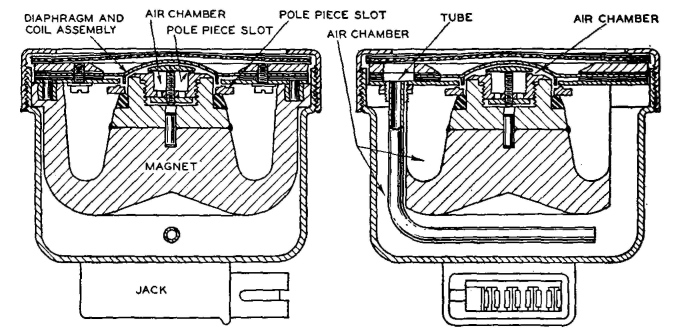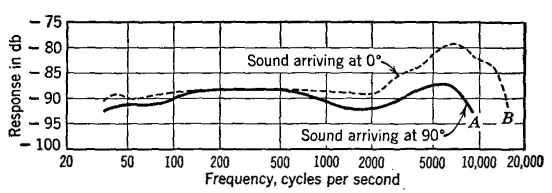| Electrical Communication is a free textbook on the basics of communication technology. See the editorial for more information.... |

|

Home  Electroacoustic Devices Electroacoustic Devices  The Moving-Coil or Electro- dynamic Microphone The Moving-Coil or Electro- dynamic Microphone |
|||||






|
|||||
The Moving-Coil or Electrodynamic (Dynamic) MicrophoneIn 1877 it was suggested17 that the performance of Bell's magnetic transmitter could be improved by making the diaphragm of non-magnetic material and attaching to this diaphragm a light coil of wire which would vibrate in a magnetic field and generate a voltage in accordance with the sounds striking the diaphragm. Such a microphone was impracticable until amplifiers were available. Moving-coil microphones became commercially available about 1930. Cross-sectional views of a moving-coil microphone are shown in Fig. 12. The diaphragm is made of Duralumin and is dome shaped to stiffen the center and ensure that the diaphragm moves with piston action. The moving coil fastened to the diaphragm consists of an aluminum ribbon wound on edge. The strong radial magnetic field across the air gap in which the coil is located is produced by a permanent magnet. As indicated by the arrows in Fig. 12 there are two major air chambers in this microphone. These chambers and the narrow connecting air slits improve the frequency response of the microphone.18,19
The shape of the housing is important in determining the directional characteristics. To obtain a non-directional microphone, a spherical housing was used in one type.20 Frequency response curves of a typical dynamic microphone21 are shown in Fig. 13.
Several hundred feet of cable may be used between the moving-coil microphone and the associated amplifier because the impedance of the microphone is only about 20 to 40 ohms. The condenser microphone element is, relatively speaking, a high-voltage low-current device of high internal impedance. The dynamic microphone element is (again speaking relatively) a low-voltage high-current device of low internal impedance. Shunting a condenser microphone with appreciable cable capacitance is objectionable but is permissible with dynamic microphones.
|
|||||
Home  Electroacoustic Devices Electroacoustic Devices  The Moving-Coil or Electro- dynamic Microphone The Moving-Coil or Electro- dynamic Microphone |
|||||
Last Update: 2011-04-12



